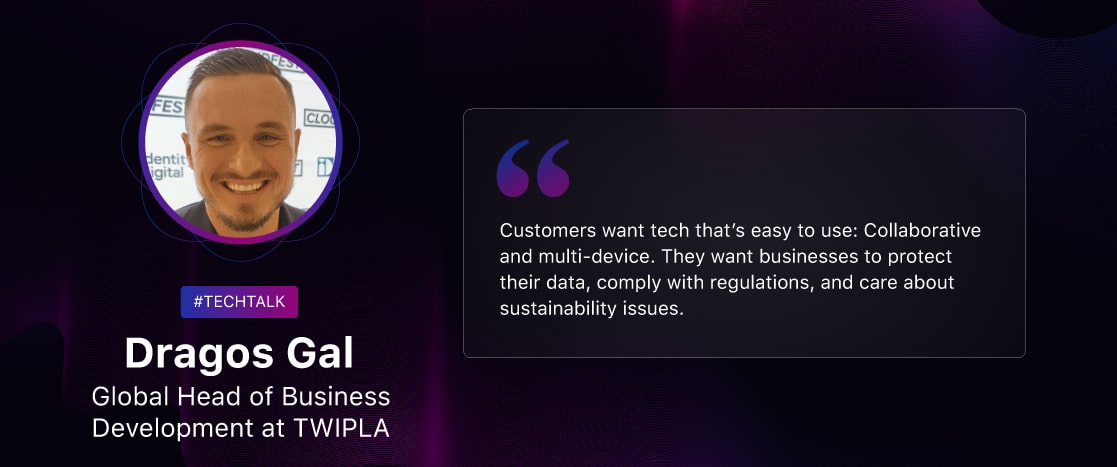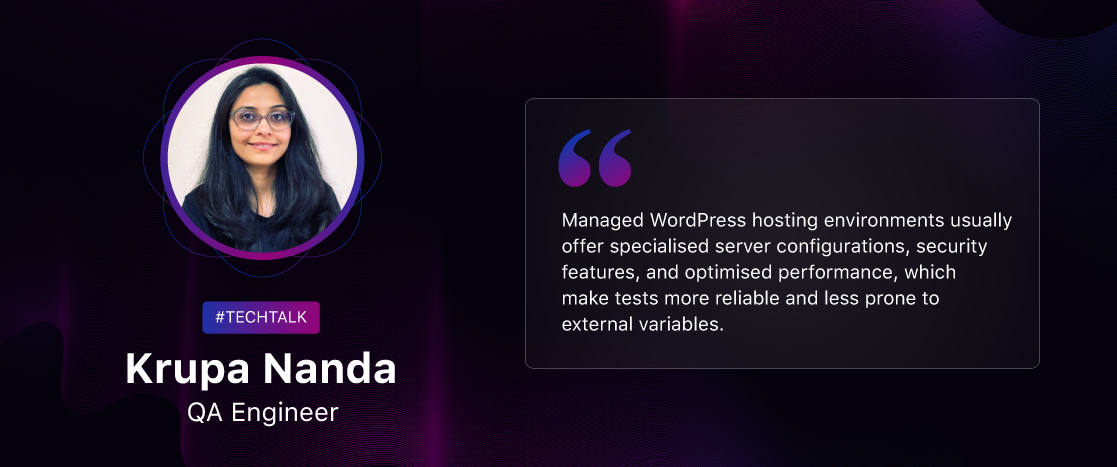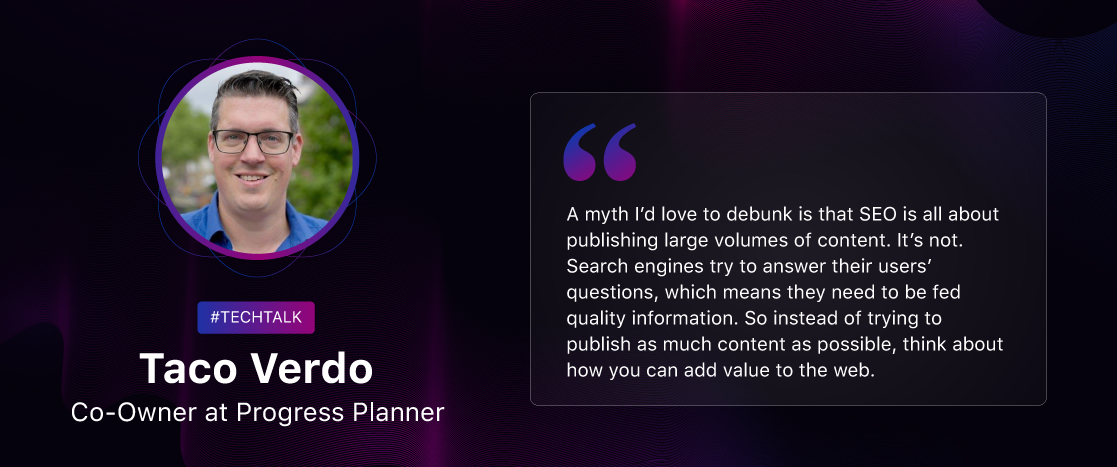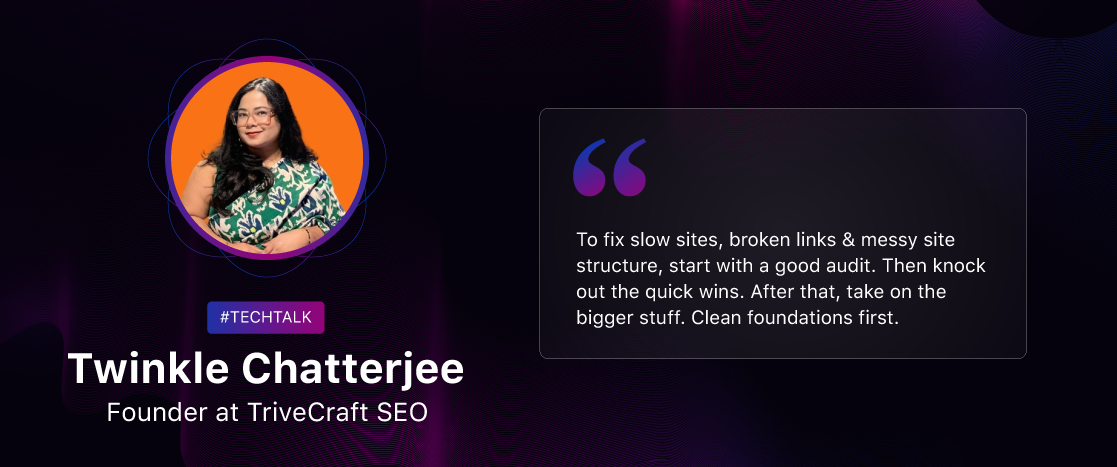
Devrims #TechTalk 061: Dragos Gal Discusses Going Cookieless
Change is the only constant and you can experience this “truth” when you are working in digital marketing. Over the last decade, marketers have repeatedly been challenged to rethink their practices. There is a delicate dance between privacy and performance: you want to know your customers, but at the same time, you do not want to scare them away by acting like a spy.
This time, I interviewed Dragos Gal who is the Global Head of Business Development at TWILPA, a unique business intelligence solution that puts privacy first.
By the end of this year, Google will be phasing out third-party cookies. A cookieless future awaits us, and that’s a good thing. Cookies should belong in bakeries, not in our browsers. As businesses like ours navigate through this new, challenging yet exciting time, we need people like Dragos to guide us.
I hope this interview will be inspirational to all marketers out there.
Devrims: Hi Dragos, thanks for your time and support. Can you briefly introduce yourself and share your background? What inspired you to pursue a career in the SaaS industry?
Dragos: Howdy everyone!
I’m Dragos Gal, the Global Head of Business Development at TWIPLA, the ultimate privacy-first website intelligence platform you didn’t know you desperately needed! With TWIPLA, you can take full ownership of your website and dive deep into your visitors’ stats, behavior, and opinions.
I’ve had the pleasure of studying and working abroad for five years across three different countries, gathering more stamps in my passport than a globe-trotting spy. Since then, I’ve been knee-deep in the worlds of business, marketing, and sales.
When I’m not strategizing world domination in a stylish knit polo, you’ll find me attempting to become a hybrid athlete—emphasis on “attempting.” If I’m not glued to a classic Western movie, I’m probably lost in a biographical book, trying to work out which parts of their characters made for such magical lives.
Devrims: Can you share the inspiration behind starting TWIPLA and its journey since its inception in 2016? What motivated you to develop a website intelligence platform that prioritizes privacy compliance and cookie-less tracking?
Dragos: TWIPLA started out as a website statistics app called “Visitor Analytics for Wix.”
Businesses had long been using this kind of software to monitor website performance and guide optimization work. But analytics had a bad reputation. It had bubbled up into public consciousness around ten years ago. I think people felt that companies were spying on them, learning more about them than they had any right to.
Personally, I remember all the bad press around analytics at that time. Since this older generation of technology did collect personal data, that wasn’t media sensationalism or tin foil paranoia. Not all businesses look after customer data with the care it demands and even scrupulous businesses suffer data breaches.
Anyway, TWIPLA was born into that climate. Our founders are German, and it wouldn’t be a lazy stereotype to say that Germans are pretty big on privacy. So from the beginning, they wanted to create a tool that businesses could use to track website performance in a way that didn’t put customers at risk.
They were also aware—like most people with their fingers on the pulse—that GDPR was on the horizon. They knew that older cookie-based analytics platforms would be first against the wall in the new privacy age that this law would usher in. So they developed a cookieless tracking system that meant businesses could use analytics without breaking privacy requirements.
That’s really the inspiration behind TWIPLA. But the platform is kinda unrecognizable from ten years ago, and that’s a reflection of the crazy speed that digital tech has developed since then. Businesses had started having to use a smorgasbord of different platforms to get the information they needed and we wanted to create one that did everything in one place. So today, TWIPLA’s got heatmaps and conversion funnels and session recordings and communication tools and more. It’s all built on the same privacy-respecting, cookieless tracking engine. Pretty cool!
Devrims: What types of insights can be gained from TWIPLA’s behavior analytics features? How does TWIPLA help businesses improve user experience through visitor communication tools?
Dragos: Visitor behavior analytics is a wonderfully descriptive term for what this pillar of website intelligence features does. They’re there so that businesses can understand how customers are actually engaging with their website. To see the website through their eyes. And they’re all basically visualizers—graphics, videos, and so forth. Put another way, they take data and turn it into appropriate formats that anyone can understand. This makes analytics accessible to everyone, and that’s an important part of what we’re trying to do here at TWIPLA.
Take heatmaps. This feature turns collective data on how traffic interacts with a webpage into an intuitive overlay. Our users can then use this graphic to see where visitors are clicking, how deeply they’re scrolling down a page, things like that. Businesses can take this information and use it to improve the positioning of important elements that they want people to see. Or they can use a heatmap to identify and rectify problems with page designs to stop people, say, clicking on things that aren’t clickable, stuff like that.
Conversion funnels are another behavior analytics feature. Basically, all websites have arteries – popular routes that people travel through on their way to buying something. A common one for webstores would be a product page to basket to checkout. Businesses want to make sure that people are being effectively funneled through these different pages. Of course, it’s a numbers game and many people will drop out for their own reasons. But businesses can still make improvements to these paths that ensure that these people don’t drop out because of reasons that are within their control.
That’s what our conversion funnels feature is for. Users can quickly daisy chain a group of pages together for analysis. And once done, they’ll get a graphic that shows the percentage of customers who enter the funnel on the first page, but who drop out as they move on through each link in the chain. They can also watch session recordings of individual dropouts to look for patterns of behavior.
This all gives businesses insight into pain points that they can then remove. They can also create and improve other funnels, lengthen ones they’ve already optimized, and, like this, turn their website into a conversion pipeline.
We’ve got other behavior tools but these two are probably enough to get your head around what they do. It’s all about providing businesses with the insights they need into website user experience, which they can then use to make everything easier for their customers. And make more sales, obviously!
Devrims: As someone skilled in marketing and positioning, what are your thoughts on the evolving landscape of SaaS marketing?
Dragos: The speed of change is certainly impressive. Much of it comes from Big Tech—Google, Microsoft, Facebook, and so forth. Marketing works in their slipstream, and we need to adapt to their developments to sustain results. These companies can kill successful marketing strategies with a single keystroke, and so SaaS companies should always keep an eye on what they’re doing.
Customer behavior and preferences are equally fluid. What they expected from businesses five years ago is light years behind what they want today. They want a seamless online experience. They want tech that’s easy to use; collaborative and multi-device. They want businesses to protect their data, comply with regulations, and care about sustainability issues. And meeting these expectations is made harder by just how much more congested the SaaS industry has become in recent years. If one company doesn’t meet all their needs, it’s pretty easy for them to jump over to an alternative.
We’ve found that success in this world comes largely from providing personalized, customer-centric experiences. And this can only be achieved by investing in data analytics and AI. But this has to be done in a way that meets high data privacy standards. That’s a balancing act, but it’s something that can be achieved with the right tools and the right knowledge base.
But of course, marketing still needs to pull new customers in. Content marketing is still important, but it has to be done in the right way. Businesses need to create communities around themselves. And they need to leverage social proof if they’re to build credibility and loyalty. So blogs aren’t enough by themselves. Businesses need to create more video content and more interactive webinars if they’re to pique the interest of people who are inundated with marketing output wherever they go.
SaaS companies should also be looking for ways to create additional product value. One good avenue is strategic partnerships with other tech companies. It’s a great way to enhance service delivery while outsourcing any heavy lifting. Another avenue is working to ensure that their product integrates well with all the technological ecosystems that people now use. SaaS businesses also need to keep pace with emerging technologies like AI and machine learning.
It’s also essential for SaaS companies to minimize any barriers to entry for potential customers. This means providing not just free trials, but also freemium packages so that people can become familiar with the tech before opening their wallets. They also need to be welcomed by effective onboarding programs and proactive customer support if any successes from marketing activities are to translate into robust user retention.
Ultimately, marketing in the SaaS sector has become much more complex. There’s a lot to think about. Here at TWIPLA, we have responded to this situation by hiring people who, together, have rich experience in all these different areas. And we make sure that we’re always learning.
Devrims: What role does social media play in your overall marketing efforts?
Dragos: Social media is definitely important, though it’s an overbooked theater and needs to be approached in the right way. We’ve got Jorge, our social media manager. He’s brilliant and seeing his vision taking shape has been one of the more interesting things for me from the marketing department over the last six months. It’s still early days and the specialism goes over my head, but his work is now bringing in a reliable lead generation stream for me. I can’t ask for much more than that!
But I can still share some pointers. LinkedIn’s the most popular space for our target audience, particularly since one of our two CEOs is something of a thought leader on privacy and tech with a large connection count that we can use to our advantage. So we’re pretty active there, and use it as a portal for our webinars, as well as for advertising product updates, marketing insights, and so on.
But we’re also active on other channels as well. Website intelligence is something that every business needs, and we don’t want to silo ourselves off from potential clients regardless of which social media platform they favor.
We’ve also recently launched a community portal of our own. It’s early days, but it’s developing nicely as a social space that our clients, privacy advocates, and analytics users can use to come together, share ideas, and work together to work out how to be successful in what has long been a pretty saturated digital space.
Looking forward, we’re planning to expand our social media presence and find new formats and approaches to communicate with our audience.
Devrims: Our readers would love to have a look at your workspace.

Devrims: What are your key tactics for identifying and targeting your ideal customer personas? How do you approach customer onboarding and ensure a smooth transition to using your platform?
Dragos: That’s a great question, and it’s really central to so much of what we do at TWIPLA! It involves a lot of research. A lot of phone calls. Some of the best intelligence actually comes from sales calls and new clients. Getting an idea for how they found us. Why they chose us. It’s really a customer-first approach. We start at the finish line – sign ups – and work back from there, looking for shared characteristics that we can then feed back into targeting work.
But we’re obviously big on data as well. And in Madalin, we have something of an analytics supermind in the office who has a natural talent for digging into analytics and identifying new customer segmentation opportunities.
And as an analytics company, we’ve also got the advantage of learning a huge amount about our users and that data feeds into our ICP development.
More broadly, we look for common characteristics like industry, customer size, and their specific needs. And we also use SEO tools to find out how our customers are finding us in the first place.
Then, we take all this information and use it to create some detailed personas that help us to guide all our ads, content creation, website design, and all the other stuff that makes up our marketing and sales strategies.
And moving on to customer onboarding, it’s also data-driven. It wouldn’t be an overstatement to say that analysis and optimization of our signup and onboarding funnel is an ongoing, weekly process. Our platform is obviously central to this. We’ve installed event triggers on every website button. We analyze our website using all our other tools as well. And we work to identify and remove any potential pain points. We’re getting there, but I don’t think this work will ever end!
At the end of the day, it’s really about making things as easy as possible for people. Marketing is suffering from tech overload these days. People don’t have the energy to be constantly learning how to use new platforms, and so we want people to be able to get value from TWIPLA from day one.
We’ve found product-led growth ideas to be really effective here. So new signups will find detailed platform walkthroughs, personalized training sessions, all that jazz. We’ve also got a huge resource library with tutorials and FAQs. And we’ve got a great support team that works away to answer any problems, and who build what they find back into our help center.
Devrims: Can you share some insights into your customer retention strategies and how you foster long-term customer relationships?
Dragos: We’ve got strong retention numbers and much of this is down to our USPs – privacy-first, all analytics tools in one place, ease of use. The competition’s not static though. And we can see that other companies are looking over our shoulder and trying to replicate what we do.
But it’s a compliment really, and it also pushes us to stay innovative and to continue rolling out new features that keep our customers loyal. I guess the right term is value delivery, but to update TWIPLA based on customer feedback rather than just industry trends. It keeps our platform relevant and valuable to our users, and keeps them coming back again and again in the long term.
Our pricing point also helps, being much lower than alternatives with similar features. Users can also jump up and down the different pricing plans when they want, and the freemium package gives people the option to close their wallets completely while still being able to use all the tools and keep their historical data.
But that’s only part of it, and our customer retention strategy is really built on providing the excellent customer support that I touched upon earlier. Many companies make it hard to find human support. That’s frustrating, and it lacks that personal connection that builds a foundation for any long-term loyalty. So our support team works to be readily available and responsive. They’re also platform experts rather than some outsourced office working off a prompt sheet. And that really helps; it means that they can offer quick and effective solutions to any problems that our users have.
Oh and one final point is community building. We try to really focus on creating a community around our brand. So we have webinars and newsletters. We have our dedicated community portal where people can communicate with each other in real-time. Obviously, our users are serious about what they do through TWIPLA, but this all also helps to foster a sense of belonging. And from the feedback we get and the many advocates we have online, this approach is certainly working.
Devrims: Do you collaborate with other SaaS companies or industry partners? If so, how do these partnerships benefit your marketing efforts?
Dragos: Absolutely. We have a large number of enterprise clients, and the nature of these partnerships means that we work closely with them to give them the service they expect. It means that we often create new tools for them, something that all our users benefit from.
We also provide different white label services for SaaS companies. And again, we learn a lot from these partners. Everyone uses our platform differently, and businesses have very specific objectives. This might be cross-domain analytics or insights into customer journeys on exiting their app. Intelligence on the businesses that their website visitors work for. Things like that. And this knowledge filters down through our marketing and dev teams and just makes us better at both building and selling the product.
We obviously also still work really closely with Wix, and we’re currently in talks with a number of other website builders that will soon be offering TWIPLA as a native integration – I can’t really say much more for the moment but it’s an exciting time for the company!
Devrims: Let’s do a quick rapid-fire round?
| Devrims | Dragos |
| Books or Movies | Books – they’re movies for the mind. |
| Day or Night | The day. As a Romanian, I don’t want to give people another reason to call me a vampire. |
| Tea or Coffee | Coffee, it’s the answer to all life’s problems. |
Devrims: As a provider of website analytics, how do you leverage data and insights to inform your marketing strategies?
Dragos: Being an analytics provider certainly makes marketing easier. It means that we kind of work within the marketing zeitgeist anyway. Plus we like to practice what we preach. It’s important at TWIPLA that everyone in the marketing team is an expert with the platform, particularly since the owners value real product-focus to all our output. Their job really is to show people what TWIPLA can do, and let the value of the software speak for itself. It’s a solid approach, and we feel that it makes our marketing more honest as a result.
So naturally, they use all of TWIPLA’s functions on a daily basis, and also work with data from external ad providers. Right now, the software’s proving really useful for A/B analytics – both with our email campaigns and wider website design. Obviously, it’s an incremental process but we’re finding it a super useful way to adapt everything to the preferences and interests of our users.
Devrims: What do you think about managed cloud hosting? What factors should individuals consider when choosing managed hosting for their website?
Dragos: TWIPLA doesn’t offer any hosting services so I wouldn’t say I’m an expert on the subject. But I’m a regular on the cloud industry conference circuit. Managed cloud hosting is a fairly new concept but it was a pretty big talking point this season. There’s a real buzz around it at the moment so you’re obviously up-to-date with the latest tech trends!
If I understand it correctly, managed cloud hosting outsources a business’s closed IT system to a single cloud provider, which handles all management and maintenance of the infrastructure. It’s a useful option, particularly for smaller companies that don’t want to pay for physical hardware and don’t have in-house IT expertise. It ensures a higher level of security than what many businesses can achieve on their own, and there are real benefits for scalability, collaboration between remote team members, and security.
The real worry for me comes down to privacy. It’s got to be a consideration in website decisions from day one, and especially so since it’s easy to get locked into a particular cloud provider. It can be hard to switch in the future, and means that poor decisions can come back and bite hard a few years down the line.
(Editor’s Note: Devrims does not have a lock-in policy.)
Managed cloud hosting also means that website data is being transferred to a third party. But the website owner still remains the data owner under data privacy regulations. So businesses need to understand the cloud host’s data privacy compliance processes, and should choose one that meets GDPR and ePrivacy requirements. Luckily, providers that are compliant do like to shout from the hilltops about it, but it’s still important to do some due diligence and confirm their marketing spiel.
There’s also the question of where the cloud host actually stores data. It’s probably stating the obvious but, despite being on the cloud, the data is still being physically stored somewhere. And if, say, this infrastructure means that website data is being transferred outside of the EU, then the business is therefore breaking the law whether they realize it or not.
Of course, there are other things to consider. The provider’s level of security, threat detection, firewalls, etc. And of course, their payment plans will be another factor. But I’d prefer to limit my answer to my specialist subject and keep any overreaching to outside of work hours!
Devrims: Suggest three individuals or industry experts we should consider interviewing next.
Dragos: Wow, only three? My role at TWIPLA is very social and I’m lucky to be leading the company’s webinar program. It means that I regularly sit down with fascinating people and it’s gonna be hard to leave anyone out but let’s see.
TWIPLA CEO Alex has to get a mention, and not just because he’s my boss! He’s our resident privacy and tech expert and he’s really active on the conference circuit. Plus, he has the gift of the gab. So, you’d have fun interviewing him and he’d make a great guest. But you probably want people outside of TWIPLA, so I’d recommend:
Alberto Di Risio is definitely one. He’s the founder of Cookieless Tech – an organization he’s set up to help businesses migrate away from cookie-based technologies. It’s a great portal, and it helps that Alberto has loads of experience in the marketing world. He’s also got a lot to say about startups, having supported over twenty of them – including some billion dollar ventures. He’s a natural conversationalist, and you’d find his knowledge about content marketing, SaaS, and solopreneurship particularly interesting.
Matthias Bettag is another top guest. He’s the Senior Data Strategist at CMP provider ODOSCOPE. He previously worked at a leading US analytics agency and was also co-chair of the Digital Analytics hub, a conference in the EU and US for the main players and key decision-makers in the industry. This has given Matthias a unique perspective on analytics for marketers that I’m sure would be of interest to your audience!
Also, if I’m allowed one little plug: both these guys are appearing on the TWIPLA webinar circuit over the next month. So if any of your audience wants to hear what they have to say about privacy, analytics, e-commerce, and all things marketing, they can find details on our LinkedIn page!






